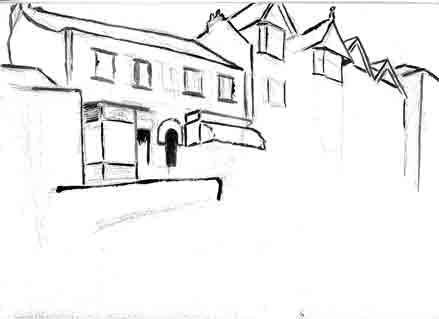The Lyme Maze Game

Emerging from the Bell Cliff passage, you enter upon the crowded scene that is Broad Street. If, as I did, you've spent your first hours in Lyme on the Marine Parade, and have just come up around the corner from there, you may be almost surprised to come upon this interior townscape. You find yourself at first on a pavement elevated about a fathom above Broad Street. Over the low parapet wall to your right, the triangular cobbled area down beside the street is called the Shambles, because it was once a meat market. Now it just affords room for two or three vehicles to park. On the left you pass three shops and then a low house bearing a plaque saying that its name is Pyne House and it "is the most likely lodging of Jane Austen, whose visits to Lyme in 1803 and 1804 gave her the inspiration for her novel Persuasion". Bellpushes by the entrance show that six people lodge here now. (Inside, a long crooked wood-panelled passage leads past their doors to the last of them, which opens to a terrace and garden descending by stages to to the Marine Parade.) Then comes Chapman's bookshop (also known as Serendip), which besides carrying books about Lyme publishes a few of them. Then Hartley's grocery, where we get all the stuff we can, because it has a wealth of fair-trade. These multicolored objects—shiny eggplants and jolly tomatoes together with Holly Hill marrows, chemical-free Somerset Wilja leeks, Aduki beans and many more—seem to spill out from the shop, which I call Hartley's Cornucopia. Indeed, you may observe that the shop has expanded: its original front still has over it the old-fashioned lettering from the fruit shop that preceded it, and then there is the windowfront that Hartley added for display, and on the glass over the door of this is a painting of a cornucopia, in lush Victorian style but done by "a lady from Axminster". Few customers notice it, because in front again hangs the striped awning that had to be added to keep rain off the further display outside. And across the sidewalk too (though leaving room, in accord with regulations, for pedestrian traffic) are yet more boxfuls of fruit and vegetables. It's an exuberant scene as in some Moroccan souk. The wall dropping from the sidewalk to the street, by now only knee-high, is Hartley's loading bay, where the van delivers his stock, like a merchant ship docking at a quay. Mr. Hartley himself bustles about, unloading and arranging. "It's the part of my job I like best", he says. (It's also my dock for leaning my bicycle and packing groceries into the panniers. Otherwise I might not have noticed that a row of tiny-flowered violets grows along the chinks between the courses of stones.) Michael Hartley's vowels are still those of his natal South Africa, which he left in 1959; he came to Lyme in 1967 and was mayor from 1989 to 1991. Has he read the tale of Michael Henchard, who drifted from far off to become The Mayor of Casterbridge (that is, Dorchester) in Hardy's great Dorset novel?—of course he has. Inside, the shop's shelves are lined with little sacks and jars—rice vinegar, hot mango chutney, wheat bran, rice fusilli, yogurt cashews, organic haricot beans, kalamata olives, piccalilli, brown bread flour, jumbo prunes, Turkish apricots, lemon verbena, St. John's wort infusion—several hundred more. There is a pleasingly basic air, perhaps given by the rough floorboards that slope toward the street. I asked him whether this was a case of the subsiding ground so common in Lyme. "No," he said, "it's been like that the thirty years I've been here. I think they just built it hastily after the fire of 1891." And he told me the history: "The shop at the top of the row, just this side of the Three Cups, was a pig-butcher's, and they had a hot fire going—they were rendering fat—and it burned down the whole row."
I crossed the street to take a look at the row. As we walk along a street we are aware of the level beside or below our eyes, the succession of shops; only in another mode do we step away and look higher, at the often different sequence of buildings from whose feet the shops peer. Chapman's and Hartley's are in the same red-brick building, with an arched doorway between them. Options and Jalitos are in a different sort of building, gable-ends-on to the street, also pierced by an archway, a wider one. Then comes the set-back front of another though similar building whose shop-level consists of Lymtina's Gifts and the Old Forge Fossil Shop. Then, after an alley, the Three Cups. It, and Pyne House at the lower end, survived the fire that consumed the row between them. The second of the archways we've mentioned gives a glimpse of sky that must be over the sea, and you may be tempted to explore through it. At the top end of the row, in front of the Three Cups, the sidewalk rejoins the plane of the street and they go on up the hill together. Update, 2006: Mike Hartley retired. At first it seemed that his shop—one of the last real shops on the street, the most real of them—would be continued by other hands. But it became "Ginger Beer", selling seaside oddments. |
